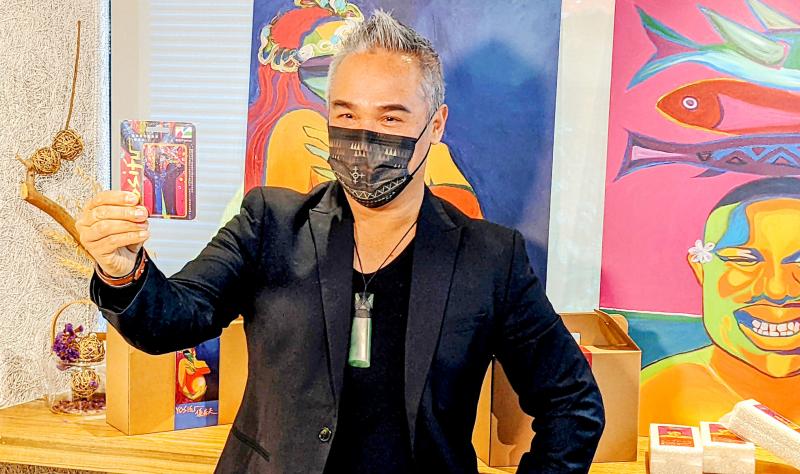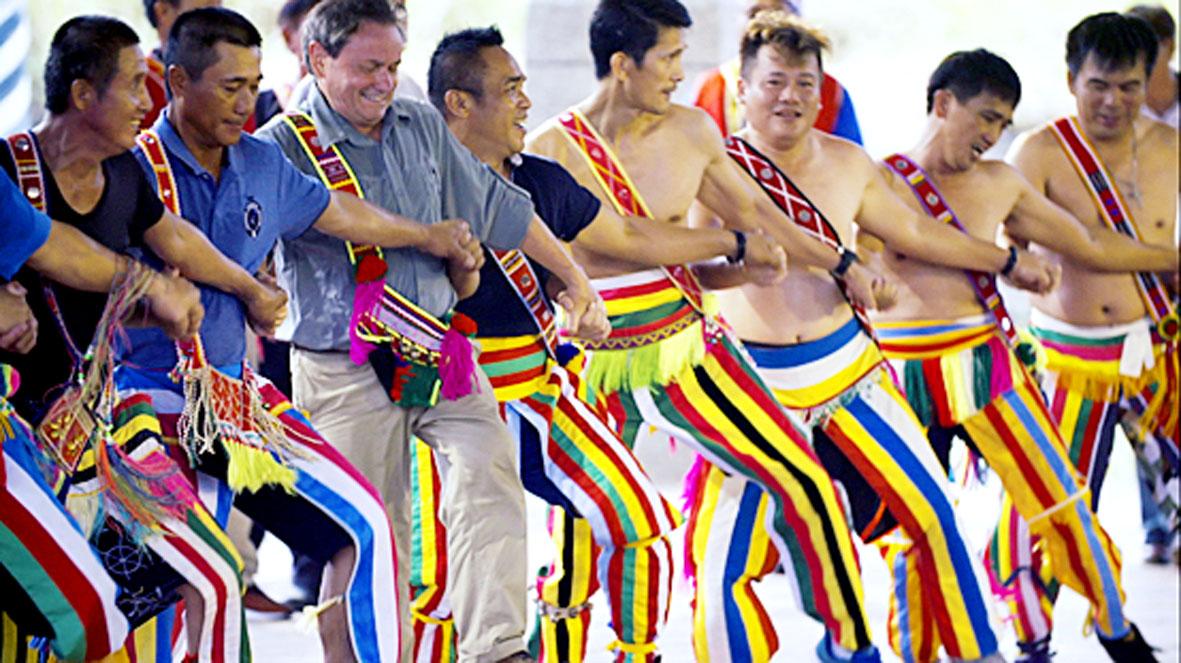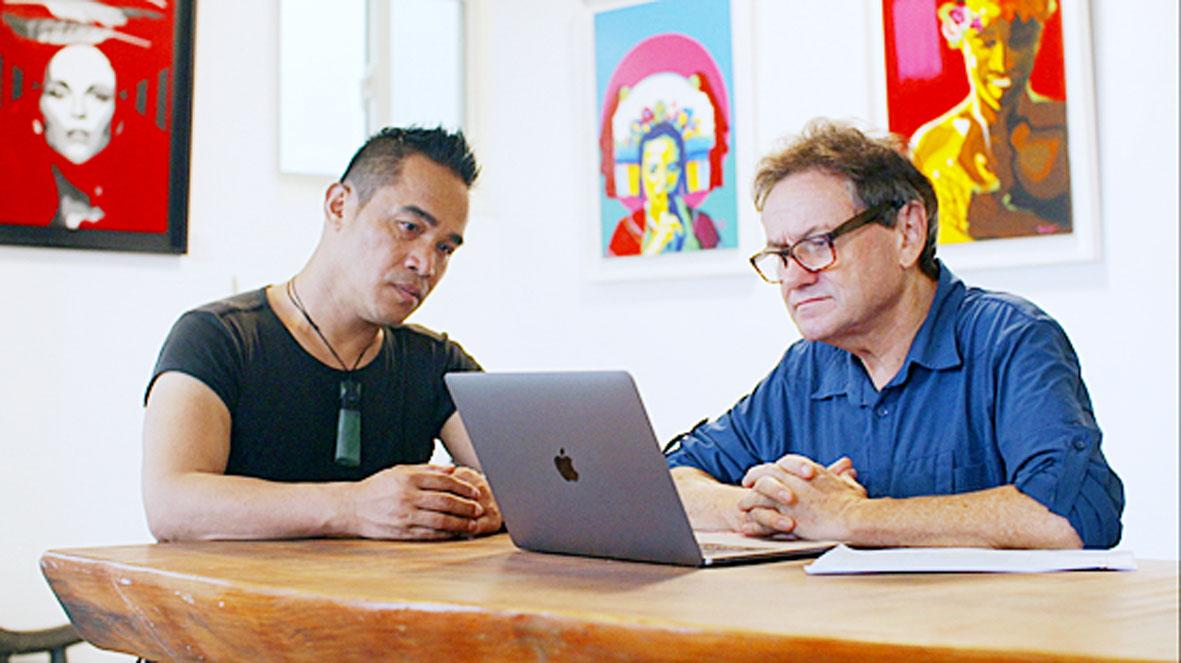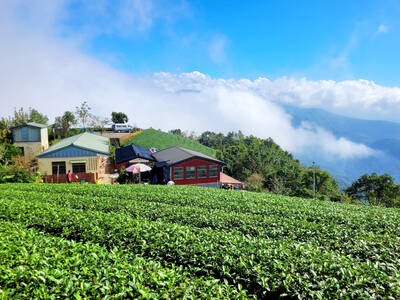Yosifu Kacaw thought National Geographic just wanted to chat about indigenous contemporary art. But at the end of the meeting, they announced: “You’re it. You will be the host!”
A confused Yosifu realized that it was a test. The production team had been searching for a co-host with British anthropologist Julian Davison for their upcoming special on the Austronesian migration, which is widely believed to have originated in Taiwan and spread as far as Madagascar, New Zealand and Hawaii.
The gregarious, animated Edinburgh-based Amis painter certainly has the personality for the task. But not only did he have no experience, he was also worried that his conversational English skills wouldn’t be enough for an academic program.

Photo: Han Cheung, Taipei Times
Yosifu took the job anyway, and he recalls tearing up when doing voiceover for a scene showing the first Austronesian explorers pushing their canoes out to sea from eastern Taiwan.
“I was moved by the bravery of my ancestors,” he says. “If they can be so brave, how could I be afraid of doing this? I want people to see that my ancestors were voyagers, and that I am so proud of them. And I hope the world can see and define Taiwan in a new light through the show.”
Premiering last Friday at 9pm in more than 40 countries, the show brings viewers through seven countries across the Austronesian world and explores the elements that connect the peoples of this vast area. There’s two more episodes to go — tomorrow’s will look at traditional wisdom such as tree-bark papermaking and pottery techniques. The finale next week focuses on symbolism, from tattoos to megaliths to architecture.

Photo courtesy of Pilot Public Relations
ISLAND HOPPING
Yosifu is also a voyager, as he splits his time between Europe and his home community of Matadim in Hualien’s Yuli Township (玉里). A fan of Discovery Channel as a child, Yosifu often wondered how amazing it would be to host one of these programs. “I feebly wished for it then, and now my dream has accidentally come true,” he says.
But the pressure was immense. Often jetlagged with no time to adjust, Yosifu says he stayed up late and woke up early every day to practice the academic terms and ideas of that day’s filming.

Photo courtesy of Pilot Public Relations
“But I was very happy because I made new discoveries everyday, just like how my ancestors discovered new lands,” he says.
Yosifu says he also felt an instant connection with the people he visited. Not only did he look like a local, there were also apparent similarities in their languages. Most of them knew of their ancestral connection to Taiwan, and the meetings were warm and natural.
“The women in Tonga all told me they were going to carry me home and feed me because I was too skinny,” he laughs.
Italian-Taiwanese director Stefano Centini knew that it was important to have an indigenous Taiwanese as one of the hosts, but he was also surprised by the level of bonding.
“We wanted an indigenous perspective ... not just on the science but about the human connection,” he says. “It was very striking ... When we went to New Zealand or Tonga and [Yosifu] was talking to the indigenous people there, I felt like I didn’t have to do much as director because the connection was so direct.”
Growing up in a time when society was harsh towards indigenous people, the 54-year-old Yosifu only embraced his identity later in life after he moved abroad. Even today, he feels that mainstream society still treats indigenous people as “exotic foreigners,” and he hopes that this production can promote general awareness — both at home and abroad — and help indigenous youth gain confidence by better understanding who they are.
“Indigenous people here have had problems with self identity due to the education system and environment,” he says. “We were assimilated into Han Taiwanese culture as children, and we never really got to learn about our distant past.”
NEW INSPIRATIONS
Amis legends say that they are the children of the sun, but Yosifu is actually deathly afraid of the heat. The self-described “polar bear” only goes home in the autumn and winter, and he hasn’t been to a harvest festival in his community for over 20 years.
He only returned in 2019 due to the filming. “It was so emotional. Nothing had changed,” he says. “They put the ceremony at the end of the program … as if it were a welcome home for me.”
One scene shows Yosifu painting a tree on a large canvas on his roof. It was another torturous scene as he had to finish it in one go under the hot sun, working for about five hours.
“They said I could paint anything I wanted to,” he says. “I painted this Tree of Life because I thought that one needs to have roots to come home. Only when you find your roots, can you become a big tree.”
“I hope I can be like a towering tree, where birds can rest, animals can live and people can find shelter from the sun and rain.”
The painting is now the face of Yosifu’s latest signature EasyCard, which was unveiled at a press conference on Tuesday. Part of the proceeds will go to the Luma Association Amis language immersion preschool, as well as a project with Guppy Inclusive, which helps indigenous farmers market organic or eco-friendly rice. With Yosifu’s painting of a pregnant woman gracing the slick packaging, they were able to bypass retailers and sell directly to customers.
It’s hard for farmers in agricultural areas to maintain environmentally friendly methods when their neighbors all spray their crops, and Yosifu hopes that these incentives will slowly change their minds.
The fellow Austronesians whom Yosifu met during his journey have also made it into his art. These pieces are on display through April 10 at the “Embrace — Austronesian Art Exhibition” (擁抱 — 南島藝術美展) at the Luodong Cultural Working House in Yilan County.
“I feel like I’m painting the descendants of my ancestors, and I’m bringing them home through art,” he says. “It’s as if I ‘drew’ them home.”

In recent weeks the Trump Administration has been demanding that Taiwan transfer half of its chip manufacturing to the US. In an interview with NewsNation, US Secretary of Commerce Howard Lutnick said that the US would need 50 percent of domestic chip production to protect Taiwan. He stated, discussing Taiwan’s chip production: “My argument to them was, well, if you have 95 percent, how am I gonna get it to protect you? You’re going to put it on a plane? You’re going to put it on a boat?” The stench of the Trump Administration’s mafia-style notions of “protection” was strong

Every now and then, it’s nice to just point somewhere on a map and head out with no plan. In Taiwan, where convenience reigns, food options are plentiful and people are generally friendly and helpful, this type of trip is that much easier to pull off. One day last November, a spur-of-the-moment day hike in the hills of Chiayi County turned into a surprisingly memorable experience that impressed on me once again how fortunate we all are to call this island home. The scenery I walked through that day — a mix of forest and farms reaching up into the clouds

With one week left until election day, the drama is high in the race for the Chinese Nationalist Party (KMT) chair. The race is still potentially wide open between the three frontrunners. The most accurate poll is done by Apollo Survey & Research Co (艾普羅民調公司), which was conducted a week and a half ago with two-thirds of the respondents party members, who are the only ones eligible to vote. For details on the candidates, check the Oct. 4 edition of this column, “A look at the KMT chair candidates” on page 12. The popular frontrunner was 56-year-old Cheng Li-wun (鄭麗文)

“How China Threatens to Force Taiwan Into a Total Blackout” screamed a Wall Street Journal (WSJ) headline last week, yet another of the endless clickbait examples of the energy threat via blockade that doesn’t exist. Since the headline is recycled, I will recycle the rebuttal: once industrial power demand collapses (there’s a blockade so trade is gone, remember?) “a handful of shops and factories could run for months on coal and renewables, as Ko Yun-ling (柯昀伶) and Chao Chia-wei (趙家緯) pointed out in a piece at Taiwan Insight earlier this year.” Sadly, the existence of these facts will not stop the